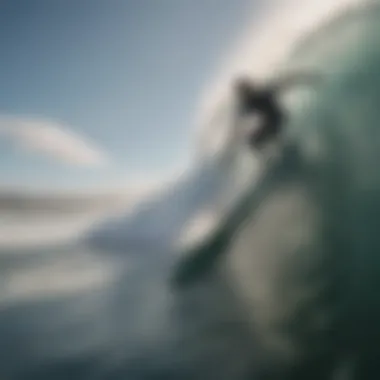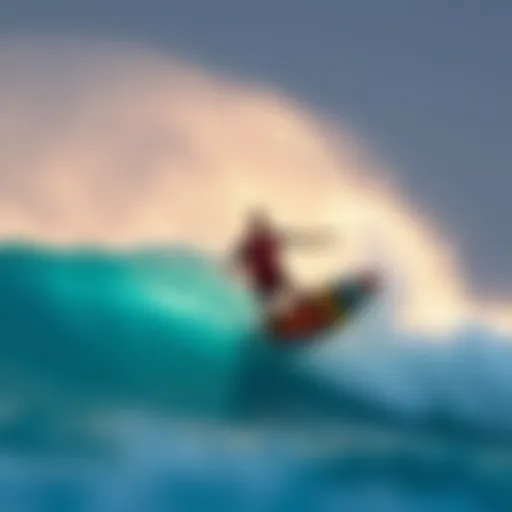Hang Ten: Surfing's Cultural Impact and Techniques
Intro
Surfing, an activity often associated with the image of sun-soaked beaches and adventurous spirits, is more than just a sport. It is a cultural phenomenon that has evolved over the decades, influencing countless lives and communities around the globe. At the heart of this culture lies the maneuver known as ‘Hang Ten’. This iconic technique represents not only a feat of skill but also embodies the spirit of camaraderie and respect for nature that permeates the surfing community.
In this article, we will explore the roots of Hang Ten, how it transformed the sport of surfing, and its significance in today's environmental discussions. We'll peel back the layers of wave riding techniques and delve into the equipment and gear that surfers swear by. From novice enthusiasts to seasoned pros, understanding Hang Ten opens doors to a deeper appreciation of surfing as an art form and a way of life.
Surf Gear and Equipment
When talking about Hang Ten, it's essential to consider the tools of the trade. The right surfboard and accessories can make a substantial difference in achieving that perfect ride.
Latest Surfboard Technologies
Surfboards have come a long way since their humble beginnings made from wood. The modern surfing experience is deeply intertwined with advancements in surfboard design. Here are some key innovations:
- Material Matters: Surfboards are commonly constructed with materials like epoxy and polyurethane, providing a lighter and more durable experience.
- Shape and Functionality: Swallow tail, fish, or longboard shapes all serve unique purposes, catering to various wave conditions. For instance, a longboard excels in smooth, rolling waves, making it easier to perform a Hang Ten.
- Hydrodynamic Designs: New technologies like concave bottoms or channels help to enhance performance. These designs optimize water flow, allowing for increased speed and control.
Essential Accessories for Surfers
Beyond the boards, several accessories are vital for a seamless surfing experience:
- Wetsuits or Rash Guards: Keeping warm in colder waters is essential. Wetsuits are designed not just for warmth but also for buoyancy and flexibility.
- Leashes: A crucial safety feature, leashes prevent boards from washing away after a wipeout, keeping both surfers and equipment safe from harm.
- Wax: Proper traction on the board is pivotal. Wax aids in preventing slips, ensuring that surfers can confidently engage in maneuvers like Hang Ten.
Techniques and Skills
Mastering the art of Hang Ten is more than just a stylish move; it requires dedication, practice, and a precise approach to wave riding.
Wave Riding Strategies
The key to successfully performing Hang Ten lies in understanding the waves and mastering balance. Here are some core strategies:
- Reading the Waves: Surfers must learn to assess wave patterns and choose the right moment to ride.
- Positioning: Getting the right stance on the board is crucial when launching into a Hang Ten. The feet should find the nose of the board comfortably, allowing for proper weight distribution.
- Technique: Keeping one’s center of gravity low while extending the toes creates that thrilling Hang Ten position. Staying relaxed can significantly enhance control and fluidity.
Safety and Surf Etiquette
Respecting fellow surfers and understanding the ocean's rhythms are paramount in this sport. Key considerations include:
- Know the Rules: Understanding right of way in the water is vital. This ensures a safe and enjoyable experience for everyone involved.
- Watch for Local Conditions: Tides and currents can change quickly. Being conscientious of these factors means surfing within your limits.
- Environmental Awareness: Surfers are stewards of the ocean. Taking care to clean up after oneself and being aware of the impacts of pollution are part and parcel of the culture.
"Every wave is a gift, and treating our oceans well is the only way we keep that gift alive."
Prologue to Hang Ten
The opening chapter of our exploration into surfing culture anchors itself in a concept that resonates deeply with both the seasoned wave riders and the curious newcomers—Hang Ten. This maneuver isn't merely a technical feat but rather a vivid embodiment of surfing's essence. It stands as a testament to the surging adrenaline rush of catching a wave, complemented by a social tapestry woven through shared experiences and camaraderie.
In the world of surfing, mastering Hang Ten transforms the surfer into an artist, balancing on a board with the grace of a dancer. The importance of this move extends beyond the act itself. It serves as a cultural marker, signifying a connection to a long-enjoyed lifestyle and community. Whether you call a beach home or simply visit, the very act of attempting this classic maneuver connects you, however briefly, with decades of surf history.
Defining Hang Ten
Hang Ten can be defined simply: it is a classic surfing maneuver where a rider hangs all ten toes off the front of the board while riding a wave. This position requires a great deal of skill, balance, and an intimate understanding of wave dynamics. Many surfers aspire to achieve this stylized position, as it represents not just technical prowess but also a visceral connection to the ocean.
- Freedom of Expression: Beyond the technical definition, Hang Ten encapsulates the freedom surfers feel as they interact with the ocean's rhythm. It’s a form of expression, a dance on water, where technique and style mesh seamlessly.
- Skill Development: For newcomers, attempting Hang Ten is often a learning curve. Riders usually begin with more fundamental maneuvers, gradually building up the confidence and technique necessary to execute this iconic stance.
Historical Context
The roots of Hang Ten can be traced back to the mid-20th century, a transformative era for surfing. Emerging from the Hawaiian islands and spreading rapidly to California, surfing became a way of life for many. The advent of longboards, which were wider and more stable, paved the way for surfers to explore more advanced techniques.
As surfing gained popularity, so too did the desire to push boundaries. Those who pioneered surfing in the 1950s and 60s, like Duke Kahanamoku and Greg Noll, laid the foundation for styles that would define the culture of riding. Surf films, music, and art began to celebrate not just the sport, but its lifestyle—a communal experience infused with a love for the ocean. The influence of surf culture spilled into mainstream media, highlighting the Hang Ten as an emblem of cool, adventure, and freedom.
"Surfing is not just a sport; it’s an emotion, a lifestyle, and an art form."
As surfing evolved, so did the Hang Ten itself. It came to symbolize not just the technical skills of a surfer but also their connection to nature. A Hang Ten ride creates a moment where the world fades away, and it is just the surfer and the wave—an experience cherished by many.


Understanding both the definition and the historical background of Hang Ten enriches our appreciation for this integral part of surfing history. This nuanced perspective reveals how this maneuver has shaped and defined the culture of surfing throughout the ages.
The Technique of Hang Ten
Understanding the technique of Hang Ten is like discovering the heartbeat of surfing itself. This maneuver encapsulates the thrill, elegance, and spirit of the sport. Getting this right not only marks a significant achievement for a surfer but also represents a deeper connection to the ocean. Hang Ten allows surfers to express their individuality, showing that the riding style can vary from person to person while still being grounded in a common technique.
Understanding the Stance
The foundation of Hang Ten lies within the proper stance. It’s not merely about standing on the board. Rather, it's about balance, poise, and control.
First off, you’ll want to establish your right or left foot forward. Balance is critical; placing your feet too close together may lead to a wipeout. Wider stances give you more stability. Here’s how you can break down the stance:
- Feet should be shoulder-width apart.
- Weight should be evenly distributed, with a slight bend in the knees for shock absorption.
- The back foot plays an important role, especially when transitioning into the maneuver.
Additionally, aligning your body with the wave helps you gain momentum. It's like drawing an invisible line along the wave's face, allowing the board to glide effortlessly. Note that a proper stance sets you up for success.
Executing the Maneuver
Once you’ve nailed the thing and feel the rhythm of the ocean, it’s time to execute Hanging Ten. Many might think it’s a simple step, but its beauty lies in its fluidity and grace.
As you ride a wave, here’s a streamlined way to perform the Hang Ten:
- Use your back foot to steer the board toward the wave’s face.
- Shift your weight forward, press your toes against the board.
- As you feel you’ve gained enough speed, step forward onto the nose of the board, extending your toes over the edge.
- Hold the stance with confidence.
- Maintain focus on the wave, keeping your body centered.
Executing this correctly usually depends on practice and patience. The thrill of riding a wave with your toes over the nose of your board is unlike any other, akin to dancing with the ocean.
Common Mistakes to Avoid
Even the most seasoned surfers slip up when practicing Hang Ten. Here's a rundown on common pitfalls that can trip you up:
- Poor Weight Distribution: An imbalanced stance often leads to falling off the board. Ensure your weight feels centered and stable.
- Overextending: Pushing too far forward can make you lose energy, which may throw you off balance.
- Neglecting to Look Ahead: Being focused on your feet rather than the direction of the wave can lead to unpredictable results.
- Practicing on Flat Waters: Start on smaller waves before attempting bigger ones. The unpredictable nature of larger waves requires experience.
"Surfing is not just a sport; it's a lifestyle that demands respect and understanding of the ocean's rhythm."
To wrap it up, mastering the technique of Hang Ten is a journey that requires commitment and awareness. Whether you’re a novice or an experienced rider, these elements will enrich your surfing experience, move you closer to those perfect wave-riding moments, and keep your passion alive.
Hang Ten in Surf Culture
Surfing isn’t just a sport; it’s a profound expression of culture, identity, and community. At the heart of this vibrant world lies Hang Ten, a maneuver that transcends mere technique and resonates deeply within surf culture. The art of Hang Ten reflects the spirit of surfing itself, showcasing a blend of skill, creativity, and connection to the ocean. Furthermore, it represents the collective ethos of surfers who share a passion for the waves and the lifestyle that comes with it.
Cultural Significance
The Hang Ten maneuver symbolizes freedom and mastery of the surfboard, appealing to both casual beachgoers and hardcore surfers alike. It signifies catching a wave and riding it with an air of nonchalance, standing on the board with ten toes over the edge. This bold act captures the very essence of surfing culture, illustrating the harmony between human and nature.
Moreover, Hang Ten embodies community values. Surfers often gather at local breaks, sharing tips and techniques, building friendships that span beyond the shore. The camaraderie and respect established among surfers create a unique culture where everyone is welcomed, regardless of skill level. This mutual support strengthens the ties within the surfing community, making Hang Ten not just a physical feat but also a cultural artifact.
"In the water, there is no time. Only the wave and the connection to each other."
In many ways, Hang Ten serves as a rite of passage. Surfers view mastering this technique as essential to gaining acceptance within their circles, leading to personal growth and confidence. As surfers push their limits and take risks, they learn valuable life lessons about perseverance, respect, and being present in the moment.
Art and Media Representation
Art and media have played a significant role in celebrating the Hang Ten culture. From classic surf films like The Endless Summer to contemporary documentaries showcasing life on the waves, these representations help amplify the allure of surfing and, by extension, Hang Ten.
Imagery captured in photographs and paintings often depicts surfers in mid-maneuver, showcasing the joy and dynamism of this art form. Notably, artists like Robert Williams and photographers such as Clark Little have immortalized the thrill of surfing, creating an iconic visual narrative around Hang Ten.
In addition, social media has further broadened the reach of surf culture. Platforms like Instagram showcase the talents of surfers around the globe, highlighting individuals mastering the Hang Ten. These shared experiences foster a sense of universality, linking surfers irrespective of geographical boundaries. The hashtag #HangTen connects a worldwide community that celebrates this iconic maneuver, enriching the cultural fabric of surfing.
The representation of Hang Ten is also present in fashion, influencing clothing lines that reflect the laid-back surfing lifestyle. Surf brands like Quiksilver and Billabong have incorporated this spirit into their designs, appealing to audiences that cherish the surf culture.
In summary, Hang Ten is a vital thread in the tapestry of surf culture. It exemplifies a lifestyle, connects communities, and is celebrated through art and media, making it more than just a surfing maneuver—it’s a badge of honor, a story woven into the sands of time.
The Evolution of Surfing Techniques


As surfing has transformed over the decades, evolving techniques have played a pivotal role in adapting to new styles, technologies, and cultural shifts. The journey of surfing techniques reflects not just the changing tides of the ocean, but also the innovation of its enthusiasts. This evolution has been shaped by a myriad of factors, including advancements in board design, the introduction of new materials, and the influence of rising surfing styles from around the globe.
From Traditional to Modern Styles
Surfing, at its inception, was a traditional art rooted deeply in the cultures of ancient Polynesians. The earliest surfers navigated the waves using hefty wooden boards, often with intricate carvings and cultural significance. Techniques were largely focused on riding straight, with little emphasis on tricks. Everything began to shift in the mid-20th century.
Modern surfing took a radical turn as shorter boards created a wave of excitement and experimentation among surfers. Fiberglass in the late '50s changed the dynamic. This new material was light, durable, and allowed for greater maneuverability. The result? The classic longboard transitioned into the more agile shortboard. Surfers began to explore new styles, executing turns, airs, and flips.
Key differences between traditional and modern styles include:
- Technique Focus: Traditional surfing focused on balance and endurance, whereas modern surfing leans heavily on agility and creativity.
- Board Shape: Traditional boards were longer and bulkier, while modern boards come in a variety of shapes and sizes to suit different wave conditions.
- Maneuvers: While traditional surfers aimed to ride the wave as smoothly as possible, modern surfers often seek to perform aerial tricks and complex turning maneuvers.
Therefore, as surfriders embraced a collective yearning for progression, new styles emerged within the surfing community.
Impact of Technology
Technology's influence on surfing cannot be overstated. Advancements have revolutionized the way surfers engage with the ocean. For instance, the rise of computer-aided design (CAD) tools allows shapers to create more precise board shapes tailored to specific wave types. High-quality materials like epoxy and advanced foam have further improved buoyancy and responsiveness.
Moreover, wave-pool technologies have opened doors for training and competitions, providing consistent wave conditions all year round. Not only does this allow surfers to hone their skills, but it also democratizes access to the sport, enabling newcomers to practice in a safe environment.
Technological advancements affecting surfing include:
- Smart Wetsuits: New materials offer superior warmth and flexibility while also integrating features like sensors that track performance metrics.
- Wearable Tech: Devices that monitor heart rates and activity levels empower surfers to analyze their performance and improve.
- Drone Filming: Video captured via drones allows surfers to critique their technique from unique angles.
As juts surfing has evolved, with technology leading the charge, it's evident that every wave tells a different story—resonating with the skill of yesteryears or the daring moves of today.
The evolution of surfing techniques is an ongoing narrative where tradition meets innovation. By understanding these changes, surfers can appreciate not just the waves they ride, but also the rich history and community that underscored their passion. The interplay of traditional and modern styles, alongside technological advancements, continues to shape the essence of surfing, making it a vibrant and ever-changing landscape.
The Role of Community in Surfing
The sense of community in surfing is as integral to the culture as the waves themselves. Surfing is more than a solo pursuit; it's a social activity that connects people from diverse backgrounds. The friendships formed in the line-up transcend typical social boundaries. Surfers often find camaraderie in shared experiences, whether it's catching that perfect wave or bracing against the elements.
Community support can elevate the surfing experience, both on and off the board. It's not just about surfing; it's about building lasting connections in a lifestyle that many regard as a family. As surfers share tales of the ocean, they weave a rich tapestry of laughter, lessons, and life stories. The ever-evolving nature of surfing culture, enriched by diverse perspectives, fosters an inclusive environment that values not only skill levels but also the bonds forged through shared passion.
Together, surfers organize events to celebrate the sport and the environment, merging enjoyment with advocacy. The sense of belonging among surfers fuels the community, ensuring that everyone feels embraced regardless of ability. In a world that often feels disconnected, surfing communities offer a haven where individuals can be themselves and share their love for the ocean.
"The ocean doesn’t just offer waves, it brings people together, one swell at a time."
Building Connections Through Surfing
When surfers hit the waves, they often encounter many others who are drawn to the ocean's allure. This shared pursuit leads to meaningful interactions. Local surf shops and beaches become gathering places as surfers congregate to swap stories, insights, and tips about their favorite spots. These encounters often lead to friendships that extend beyond surfing.
From dusk-till-dawn surf sessions to casual meet-ups for sunset watch, the bonds created in the surf community can lead to lifelong friendships. As new surfers learn from veterans, they integrate into the fabric of the local surf culture. Mentorship plays a significant role too; experienced surfers frequently pass down knowledge about techniques, equipment, and safety, ensuring that the spirit of surf tradition continues.
Benefits of connecting through surfing:
- Shared knowledge and techniques enhance personal skills.
- Emotional support during times when conditions aren’t optimal.
- Opportunities for adventure through group trips and surf camps.
Collaborative Surf Events
Collaborative surf events are another hallmark of the surfing community. These gatherings go beyond competition; they emphasize unity, enjoyment, and environmental awareness. Events such as beach clean-ups or fundraiser contests highlight the community's responsibility towards ocean preservation. Surfers come together, pooling resources and skills to contribute positively to their surroundings, fostering a sense of stewardship for the ocean.
Often, these events feature friendly competitions that encourage camaraderie. Surf contests are not just about winning; they bring surfers together, celebrating shared experiences. Whether someone walks away with a trophy or just a few laughs, the overall atmosphere is celebratory. This spirit nurtures friendships among surfers who might otherwise only exchange nods in the water.
Key examples include:
- Local surf festivals: Showcase talent, art, and surf culture.
- Charity competitions: Raise funds for marine conservation or local communities.
- Workshops: Teach sustainable practices and environmental awareness.
The collaborative nature of these events not only enriches the surfing community but also reinforces the ethos of care and respect for the ocean. An engaged community directly influences the future of surfing, ensuring that values of friendship, collaboration, and environmental stewardship persist in the next generation.
Environmental Considerations
Understanding the role of environmental factors in surfing is essential for surfers, ocean lovers, and environmental advocates alike. As much as riding waves offers an exhilarating experience, it carries the weight of responsibility to protect the delicate ecosystems entwined with our oceans. By examining the implications of surfing on marine environments, alongside potential solutions through sustainable practices, we can foster a healthier relationship with nature.


Impact of Surfing on Marine Environments
Surfing thrives on the close connection between rider and the sea, yet this relationship is not without its challenges. The sport can inadvertently affect marine environments in several ways:
- Pollution: Surfing-related activities often lead to increased litter, with used wax, plastics, and other waste ending up on beaches and in the water.
- Coastal Development: The growth of surf tourism has prompted the construction of resorts and facilities, leading to habitat destruction and alteration of natural coastlines.
- Wave Conditions: The presence of surfers can sometimes lead to shifts in local wave conditions, affecting the natural patterns of ocean flows.
Ultimately, these elements underscore the importance of embracing fisheries, marine plants, and ocean life, which have profound implications for sustainability. The thriving marine ecosystems contribute to not just the health of the ocean but also enhance the overall surfing experience.
"Consider the waves you ride as they ride back over you; we share this water with countless lives beneath the surface."
Sustainable Surfing Practices
In light of the various environmental impacts, the surfing community is increasingly gravitating towards sustainability. More than just a trend, adopting eco-friendly practices helps to ensure that future generations can enjoy the same waves we do now.
Implementing sustainable practices includes:
- Eco-Friendly Surfboards: Many brands are now producing boards made from sustainable materials, such as recycled polystyrene or bio-resins, reducing the carbon footprint of manufacturing.
- Using Biodegradable Wax: Switch to eco-friendly wax that doesn’t harm the ocean when it washes off during surfing.
- Participating in Beach Cleanups: Many surf schools and communities organize regular beach cleanup events to remove debris and keep our waters clear.
- Educating and Advocating: Knowledge-sharing about marine conservation and the importance of protecting ocean health can inspire both seasoned surfers and newcomers to adopt more sustainable habits.
By making conscious choices, surfers can enjoy their passion while ensuring their beloved oceans remain vibrant and intact. The interplay between surfing and environmental stewardship is crucial, linking the spirit of the sport to the preservation of the natural world.
Adapting to Changing Conditions
Surfing isn’t just about catching waves; it’s a dance with nature. Adapting to changing conditions is something every surfer must learn to embrace. The ocean is unpredictable and constantly shifting due to a variety of factors—wind, tides, storms, and even the geography of the coastline. Understanding these elements not only enhances the Hang Ten experience but also keeps surfers safe and improves their skills over time.
The first major consideration is weather patterns. Forecasting surf conditions can be a bit like reading tea leaves. Different winds create different wave heights and shapes; for instance, onshore winds tend to flatten waves, while offshore winds can help produce those high, peaky waves surfers yearn for. Knowing when to hit the water based on this knowledge can really make or break a session.
Additionally, awareness of wave dynamics—the way waves interact with the ocean floor due to factors such as swell direction and tidal influences—plays a crucial role. Each surf break has its unique characteristics, which can transform dramatically with slight changes in these conditions.
"Surfing isn’t just a sport; it’s an ever-changing dialogue with the ocean. Understanding this dialogue can only lead to deeper connection and satisfaction."
Being aware of such nuances allows one to maximize the thrill of Hang Ten. Not only does it allow a surfer to respond competitively, but it also teaches the importance of respecting the environment.
In the long run, adapting to the conditions will expand your skills. It strengthens decision-making, boosts confidence, and enhances enjoyment. The ability to pivot and adjust is crucial, especially when you're fighting for those coveted waves.
Weather and Wave Dynamics
The symbiotic relationship between weather and wave patterns is fascinating. For surfers, a solid grasp of how these elements play off each other can lead to a more fulfilling surf session.
- Wind Direction and Speed: Wind can enhance or hinder wave quality. Depending on how hard the wind is blowing and which way it’s heading, the resultant waves can vary significantly.
- Tides: The tidal cycle is essential. During low tide, waves interact differently with the seabed than they do during a high tide. Each surf spot often prefers one over the other. For example, certain reefs work best with a mid to high tide, while others are more forgiving at low.
- Swell Period and Size: Bigger isn’t always better. The interval between swells can impact the way waves break. Long intervals usually mean cleaner, more well-formed waves, while shorter intervals may present choppy conditions.
Understanding these dynamics gives surfers the knowledge to choose the right times to paddle out. Mastering them is akin to deciphering an open book, rich with secrets waiting to be uncovered.
Personalizing Your Hang Ten Experience
Every surfer has their own rhythm. Personalizing the Hang Ten experience starts from understanding your unique style and preferences. It’s about knowing how you ride the wave and what gear complements your approach.
- Choose Your Board Wisely: The board you ride has a profound impact on your experience. A longboard offers stability for a classic Hang Ten, while a shortboard may facilitate quicker maneuvers and tricks.
- Local Knowledge: Each surf break comes with its unique set of challenges and accents. Getting to know your local spots allows you to find waves that suit your style. Surf locals often have gems of wisdom to offer, so don't be shy to ask.
- Mindset: Having the right mental approach can transform your surf. Focus on being present in the moment rather than obsessing over techniques. Enjoy the ride, and let the ocean guide you. This can often lead to spontaneous breakthroughs in skills.
By personalizing your experience, you set the stage for a deeper connection with the waves you ride. This connection often fuels a lifelong passion, making every Hang Ten much more than just a maneuver—it's an expression of your journey with the sea.
The Future of Surfing
The future of surfing stands as a testament to the creativity, resilience, and adaptability of the surfing community. As we move into an era marked by rapid change, surf culture is evolving in ways that pose new challenges and opportunities. With the advent of advanced technology, shifting environmental conditions, and a generation of environmentally conscious youth, the art of surfing is blending tradition with innovation.
Emerging Trends and Techniques
Surfing is not just about riding waves; it's also about embracing new methodologies that enhance performance and connection to the environment. These trends often stem from the fusion of technology with the surfing experience.
- Artificial Waves: Several surf parks have emerged worldwide, pushing the boundaries of where and how surfing can occur. Facilities like Surf Ranch in California allow surfers to train on perfectly formed waves, regardless of ocean conditions. This trend opens doors for skill development and accessibility, attracting novices and experts alike.
- Eco-Friendly Boards: As sustainability takes center stage, surfers are increasingly opting for environmentally friendly gear. Brands such as Firewire and Lost Surfboards are producing surfboards using sustainable materials, reducing carbon footprints, and supporting ocean health.
- Smart Wearables: Technology has made its mark on individual performance tracking. Wearables like the Motionize surfing tracker leverage data to enhance a surfer’s skills. Such innovations can analyze techniques, helping surfers understand their rides better.
- Interactive Surf Experiences: The rise of virtual reality (VR) is bridging gaps for those unable to access real waves. Surfing simulators are now found in urban areas, allowing aspiring surfers to practice their skills in a controlled environment.
These trends not only elevate the sport but also ensure that surfing continues to attract new generations without losing its core values.
The Role of Youth in Surf Culture
The youth today are often viewed as the torchbearers of tomorrow's surf culture. They influence social dynamics, push for technological advancements, and advocate for environmental protection. This demographic embraces surfing not just as a sport but as a lifestyle and vehicle for positive change.
- Sustainability Advocates: Young surfers are increasingly aware of the impact of climate change on their favorite waves. Initiatives led by organizations like Surfrider Foundation are gaining traction, encouraging clean-up efforts, and raising awareness around ocean pollution.
- Diverse Representation: Surfing is becoming more inclusive, welcoming individuals from diverse backgrounds. Young surfers break traditional molds, bridging cultural gaps, and fostering a sense of community that transcends geographical boundaries.
- Digital Pioneers: With growing social media influence, the youth showcase their surfing experiences, creating an online culture that's vibrant and relatable. Platforms like Instagram and TikTok have become avenues for spreading awareness and celebrating surf culture, allowing talent to shine beyond local circles.
The future of surfing rests in the hands of its youth—a generation that embraces change, values community, and understands the delicate balance of enjoying the waves while preserving them for the future.















